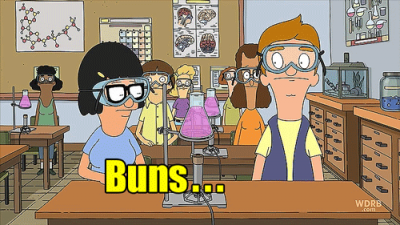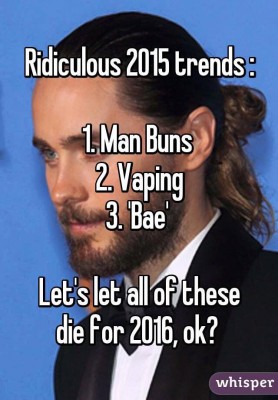2015 was full of trends that we loved to hate: the dress, minions, vaping, hoverboards… it has been a veritable cornucopia of listicles and memes bemoaning the sad state of popular culture. But one stands out to me as particularly partisan, capable of tearing families apart, more controversial than the pumpkin spice lattes or Crocks of years past. That’s right—I’m talking about the man bun.

It started with Jared Leto, the original poster boy for man buns. Leto could probably shave Donald Trump’s face into the side of his head and make it look sexy, so it’s no surprise that he looks great in a man bun. And much of the criticism of man bun popularity is that not everyone can “pull it off,” something most of us have said to ourselves at one time or another. For femme folks, it might be cherry red lipstick or high-wasted cut off shorts. For masculine people, maybe it’s suspenders or brightly patterned ties. But by far, most of the hate directed at the man bun stems from one perception: it’s girly.
In a survey conducted by the noted polling outlet West Coast Shaving 62% of women say they dislike or hate man buns. When asked what adjective first comes to mind when seeing a man with a bun, the top response was “feminine.” Most women also replied that they would not date a man who wears his hair in a bun. Men’s Fitness also did an informal poll on man buns, and out of 100 women they asked 74 said they did not like them. Women responded with concerns about hair tie sharing, praise that buns expressed confidence in one’s masculinity, and the very straightforward belief that buns are for women only.
Another criticism of man buns is that they’re hipster, but I would argue that this is also tied to modern complications of masculinity. The jokes about male hipster aesthetics are typically that they’re too sensitive, their jeans are too tight, their beards and hair too well coiffed. I won’t get into all of the more substantive critiques of hipsters like gentrification and appropriation of black, working class, and Native American culture, though they are many. My point here is that drawing a distinction between the gender-policing and hipster-hating response to man buns is dubious.
So where does all of this leave men who complicate or push the boundaries of gender conformity? In her work on gender and performativity, Judith Butler defines gender as the “stylized repetition of acts” that contribute to the perpetuation of the “compulsory heterosexual matrix”—all of those systems and cultural norms that demarcate who is accepted and who is considered dangerous to the societal status quo. LGBTQ individuals have faced discrimination and violence throughout history for violating these norms and for challenging the heterosexual matrix, though slow progress on that front will hopefully continue to mitigate that discrimination. Perhaps the most dangerous of all to this system are transgender people, who not only challenge codified gender behavior and sexual desire, but the very concepts of biological sex that are deeply entrenched in the most basic institutions of our society.
So, here is my argument: man buns are dangerous. I don’t mean to overstate the issue, but challenges to masculine norms by those perceived to be otherwise very masculine throw the institution of sex and gender into disarray. Varieties of identity that draw on both masculine and feminine traits are particularly confusing. Male cheerleaders are explained away as wanting to touch their peers’ butts (or being gay), drag performers are considered safe and entertaining only when onstage and in a controlled environment, and bisexual women are “going through a phase” while bisexual men are erased altogether. Queering the line between masculine and feminine, or erasing it altogether for gender non-conforming individuals, is not only provocative—it threatens to dismantle the compulsory heterosexual matrix altogether. And it puts individuals’ lives at stake. It inspires outrage and fear, but also progress and better understanding of the complex spectrum of human behavior.
Are man buns revolutionary? Probably not. Will they single-handedly disrupt or deconstruct the compulsory heterosexual matrix? No. But they might tell us something about the limits of masculine femininity. Who can and can’t “get away with” a man bun tells us who can transgress those norms and who can’t. Handsome movie stars are celebrated for sporting a bun, while effeminate hipsters, those deemed conventionally unattractive, or those who otherwise do not project confidence in their masculinity can’t pull it off.
Why do we hate the man bun? What is the heart of a critique that says men shouldn’t wear their hair in a way typically reserved for women? We can dismiss the whole affair as more backlash against something trendy, and certainly that’s at play. We love hating things that are popular. But I think there’s something else too. I think we’re a little afraid of the man bun. It’s one more chip in the already fragile set of cultural mores that tells us how to categorize one another, how to box ourselves into male and female compartments. But don’t be scared. It’s just a bun.
Britney is on Twitter.


Comments 5
BMICHAEL — January 5, 2016
¯\_(ツ)_/¯
as a man with long hair and no desire for it to mix in his mouth with food and drink, the man bun will have to do. i didnt really understand this piece but im assuming its clever or something.
DTI — January 5, 2016
Second of all, the biggest complaint, seemingly more from women than men, is that they're feminine? Really? What year is this, 1963? Can't tell whether Jared Leto, David Beckham, or John Belushi is a boy or a girl?
And where did the "man" part of man buns come from? In the early 60s they didn't call the Beatles hair style "man bowl cuts." When hippie men tied back their hair they didn't call them "man pony tails." And in the 1700s neither founding fathers nor English sailors braided their queues into "man pigtails."
Just guessing here but it probably wasn't men who wear them who started calling them "man buns." So it might be a gender-derision term but it's probably not a term of gender-anxiety.
And gender bending or challenging masculinity? Bwahahah! I'd have thought a more likely criticism would be that buns on men falls in the same too-heterosexual category as fedoras, neck beards, mutton chops, black duster jackets, water-cooled gaming computers.
I'm not criticizing your analysis, Britney. My expectations had been that attitudes and discourse on gender and, especially, gender and male heterosexuality had progressed since the mid-20th century. As you nicely point out there's a long way to go. Thanks for the head's up!
Minka — January 8, 2016
I think you get at the real issue when you say: "Who can and can’t “get away with” a man bun tells us who can transgress those norms and who can’t. Handsome movie stars are celebrated for sporting a bun, while effeminate hipsters, those deemed conventionally unattractive, or those who otherwise do not project confidence in their masculinity can’t pull it off." But, I don't think it is a matter of who can and cannot "transgress those norms," but who is and who isn't already considered "masculine." I don't think there is anything inherently "feminine" about a "man-bun," but -- considering that gender normative behaviour is constantly under a state of re-definition and considering that we are probably, now, in a mode of shift -- the ability to "pull-off" or not a "man-bun" does seem to become an indication of whether or not a male seems to be projecting the "masculinity" we have yet to clearly define -- a priori "man-bun." In other words, the "man-bun" is only read as feminine on a man that was already being read as feminine; football player + man bun == man who wants to sport long locks but does not want them to become a liability during his "manly" sporting activities. --thoughts
Ronen — January 12, 2016
Seeing man buns listed on Product Hunt is what ruined that site for me.